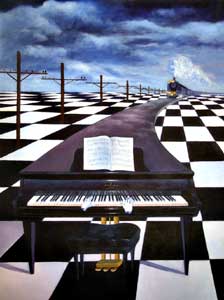|
Audio
Photos
Resources
Respond to this story
|
Dali lives on in Wayzata
December 3, 2004
 |
| "Road to Nowhere," a painting by artist Leonid Shchigel. Shchigel has opened a new gallery in Wayzata dedicated to Salvador Dali-style surrealist art. (Image courtesy of Leonid Shchigel) |
Wayzata, Minn. — One painting in 25-year-old Leonid Shchigel's new Wayzata gallery exemplifies his surrealist vision.
It shows a jet black baby grand piano sitting on a checkerboard landscape. Two white-gloved hands float above the keys, preparing to play. The piano lid extends into the distance, curving right to become a road. On the horizon a steam locomotive chugs toward the viewer, on the piano top.
 | |||
The painting definitely has Dali written all over it, but it came from somewhere in Shchigel's subconscious.
"In your head things are not really what they seem, they're kind of changed," he says. "But for me it's normal. That's what surrealism is all about -- changing the reality."
How Shchigel went from a young man with no art background to the owner of Art World Fine Art Gallery in the high-rent district of downtown Wayzata is an interesting story.
He was born in the Ural Mountains of Siberia, a self-described child of Perestroika. He and his mother and sister moved to Minnesota in 1994, after his father died.
Shchigel loved to draw as a kid, but he didn't pursue art any further than that, until he got a job in the Twin Cities as a security guard. Working the graveyard shift, he had a lot of time on his hands.
 | |||
"I was painting a lot at night at security where I worked," he says. "And that's how I developed my own art."
Shchigel is completely self-taught. He also learned how to create digital art and became familiar with the Internet while working security. He doesn't have a fine arts degree, nor a need for one.
"School is good," he says. "School will teach you how to paint, I mean, it gives you basic rules. But then on some level, school kind of destroys your talent."
Besides he says, Dali never finished school. Shchigel discovered Salvador Dali on his own in books and on Web sites, and he says Dali's work spoke to his own surrealist mentality. Shchigel views himself as a surrealist who happens to paint.
"Everything I do, it's like, it's against logic," he says.
 | |||
Logic, rational thought, reason, whatever you call it, has failed mankind, Shchigel says. When asked to elaborate, he pauses, then says he's unsure whether his English skills can convey what he means.
"Logic is... is destroying feeling," he says.
In his art, Shchigel escapes the oppression of logic. Dreams are his main inspiration.
One work at the gallery is of a multi-level chessboard seemingly implanted in the silhouette of a woman's head, which appears to hover in clouds. Another computer-generated piece features coffee cups and saucers floating on or over a placid sea, where golden statues with faucets for heads arise out of the water.
As for what they and his other pieces might signify, Shchigel says he doesn't know.
 | |||
"That's the thing," he says. "I can't describe nothing. This is surrealism, and you get what you see basically."
In the 1920s, surrealists were interested in unlocking the imagination and revealing the subconscious. They rebelled against realism in art and depictions of everyday life. After World War II, the larger movement lost its cohesiveness.
University of Minnesota art history professor Rob Silberman says he understands how Leonid Shchigel was attracted to the movement's original champions.
"There are always going to be people drawn to it," he says, "and working in styles that are more surrealistic than, say, straight representation, traditional realism or the other kinds of abstraction."
Silberman also took a look at images of some of Shchigel's pieces at his Web site.
 | |||
"He is talented, and he's also very young," he says.
Silberman says Shchigel is clearly heavily influenced by Dali and other surrealist masters.
Shchigel opened his own gallery because of the unenthusiastic response he got from other galleries around town. He plans to show other artists as well.
He's not sure what kind of business he'll do in Wayzata, but he has sold a lot of pieces to Europeon buyers through the Internet. He's determined to make a living as an artist.
"I would sell it on the street," he says. "And if I couldn't sell it, I'll go somewhere else and try."
Shchigel says if surrealism doesn't sell, he'll paint flowers, landscapes, abstract art -- anything that will help him avoid working a regular job.
|
News Headlines
|
Related Subjects
|
